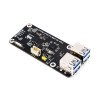






zł51.41 tax excl.
PCIe TO USB 3.2 Gen1 Board (C) is a functional expansion for the Raspberry Pi 5, enabling the connection of four high-speed USB devices with independent power management. It is ideal for applications requiring multiple ports, such as laboratories, workstations, or automated systems, where stability, performance, and full control over peripheral devices are essential.
The PCIe to USB 3.2 Gen1 Board (C) adapter for Raspberry Pi 5 expands the number of available USB ports by adding four high-speed USB 3.2 Gen1 connectors. Each port supports transfer speeds up to 5 Gb/s (up to 500 MB/s total). The device operates in plug-and-play mode without the need for driver installation and is fully compatible with Raspberry Pi OS. Additionally, each USB port can be individually powered on or off via software commands, allowing precise peripheral power management. The adapter mounts laterally using an acrylic base, saving space above the Raspberry Pi.
Manufacturer BTC Korporacja sp. z o. o. Lwowska 5 05-120 Legionowo Poland sprzedaz@kamami.pl 22 767 36 20
Responsible person BTC Korporacja sp. z o. o. Lwowska 5 05-120 Legionowo Poland sprzedaz@kamami.pl 22 767 36 20
The PoE M.2 E KEY HAT+ Acce A kit expands the capabilities of the Raspberry Pi 5 with modern communication interfaces and Power over Ethernet (PoE) power supply. It enables the use of the Intel AX210 wireless module with support for Wi-Fi 6E and Bluetooth 5.3, providing fast and stable network access as well as wireless connectivity. With 5 V and 12 V power outputs, the adapter also serves as a power source for additional modules and devices in networking, industrial, and IoT projects.
PCIE TO 4-CH NVME Board (B) (US) is a reliable solution for expanding the Raspberry Pi 5 with high-speed data storage using four NVMe drives. Ideal for server applications, workstations, AI projects, and home NAS setups, it offers high performance and comes with a US plug power supply included.
No product available!
The PCIe To M.2 MINI adapter allows the Raspberry Pi 5 to be expanded with a high-speed NVMe SSD, offering high bandwidth and the ability to boot the system directly from the drive. Its compact form makes the module ideal for projects that require high computing power and fast data access within limited mounting space. It is well-suited for file systems, servers, terminals, and embedded projects using the Raspberry Pi 5.
No product available!
PoE HAT (G) allows Raspberry Pi 5 to be powered without the need for an additional power cable, using only an Ethernet cable compatible with Power over Ethernet technology. With high output power and a compact design, the HAT is ideal for projects requiring stability, space efficiency, and clean integration—especially when used with the official Raspberry Pi 5 case.
No product available!
Overlay module for Raspberry Pi with GSM, GPRS, GNSS and Bluetooth
Expansion board with LoRa E22-400T22S module for Raspberry Pi. It supports the LoRaWAN protocol and allows communication in the 433 MHz frequency band. Waveshare SX1268 433M LoRa HAT
No product available!
The EM060K-GL LTE Cat-6 module kit is designed for use with the Raspberry Pi minicomputer. It supports communication over the high-speed LTE-A network and GNSS positioning. Waveshare EM060K-GL LTE Cat-6 HAT
No product available!
UART debugger module designed specifically for Raspberry Pi 5. Allows easy connection to UART debug connector via SH1.0 3PIN cable, ensuring convenient and effective debugging. Waveshare Pi UART Debugger
Expansion board with LoRa Node SX1262 module dedicated for Raspberry Pi. It supports the LoRaWAN protocol and allows communication in the 433 MHz frequency band. Waveshare SX1262 433/470M LoRaWAN HAT
Set with SIMCom 5G SIM8202G-M2 module designed to work with the Raspberry Pi minicomputer. It supports 5G SA or NSA networks and is backwards compatible with 4G and 3G networks. Waveshare SIM8202G-M2 5G HAT (B)
PCIe TO 2-CH PCIe HAT is a versatile PCIe expansion board for Raspberry Pi 5, enabling simultaneous connection of two PCIe HAT modules. With support for stacked mounting and the PCIe Gen2 standard, it is an ideal solution for testing, expansion, and prototyping devices using Raspberry Pi 5 and high-bandwidth interfaces.
Expansion board with LoRa Node SX1262 module dedicated for Raspberry Pi. It supports the LoRaWAN protocol and allows communication in the 868 MHz frequency band. Waveshare SX1262 868/915M LoRaWAN HAT
The PCIe to M.2 Board (E) adapter for Raspberry Pi 5 enables integration of high-speed NVMe M.2 drives and efficient cooling thanks to a PWM fan and heatsink. Its compact design, compatibility with 2230/2242 formats, and full integration with the Raspberry Pi 5 board make the module ideal for projects that require high disk performance and reliable operation.
Expansion board with GSM/GPRS module designed for Arduino and Raspberry Pi. It uses the Quectel M95 chip, the board has two audio connectors, a microSD slot and a dual SIM slot. A-GSM II Shield
No product available!
Expansion board with LoRa E22-900T22S module for Raspberry Pi. Allows communication in the 868 MHz frequency band. Waveshare SX1262 868M LoRa HAT
No product available!
Compact 4G LTE HAT for Raspberry Pi, ideal for remote IoT projects operating without Wi-Fi. Includes SIMCom A7683E modem, SIM connector, SMA antenna, user buttons and Qw/ST port for easy expansion. No soldering required and great for mobile or field installations. Pimoroni PIM717
No product available!

PCIe TO USB 3.2 Gen1 Board (C) is a functional expansion for the Raspberry Pi 5, enabling the connection of four high-speed USB devices with independent power management. It is ideal for applications requiring multiple ports, such as laboratories, workstations, or automated systems, where stability, performance, and full control over peripheral devices are essential.
